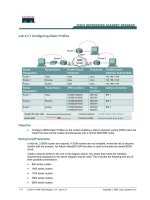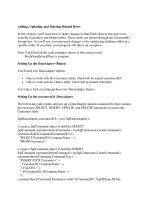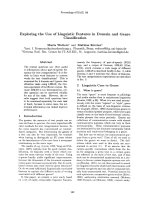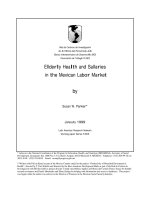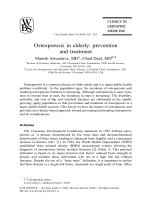IN THIS ISSUE: SEGMENT REPORTING potx
Bạn đang xem bản rút gọn của tài liệu. Xem và tải ngay bản đầy đủ của tài liệu tại đây (991.89 KB, 11 trang )
IFRS FOR INVESTMENT FUNDS
December 2011, Issue 2
Welcome to the
series
Our series of IFRS for
Investment Funds publications
addresses practical application
issues that investment funds
may encounter when applying
IFRS. It discusses the key
requirements and includes
interpretative guidance and
illustrative examples. The
upcoming issues will cover
such topics as classiication
of redeemable shares, fair
value and IFRS 9 Financial
Instruments.
This series considers
accounting issues from
currently effective IFRS
as well as forthcoming
requirements. Further
discussion and analysis
about IFRS is included in our
publication Insights into IFRS.
In this issue: Segment reporting
IFRS 8 Segment Reporting introduced segmental disclosure requirements based on
the information that management uses to make decisions about operating matters.
The application of the standard by investment funds may require a signiicant
amount of judgement. This issue covers the following IFRS 8 requirements.
1. How does a fund determine whether it falls within the scope of IFRS 8?
2. How is ‘traded in a public market’ deined?
3. What steps should you go through to determine reportable segments under
IFRS 8?
4. How do you identify the chief operating decision maker (CODM) for a fund?
5. How do you identify operating segments?
6. When may a fund aggregate operating segments?
IFRS 8 requires segment disclosure based on the components (operating segments)
of the fund that management monitors in making decisions about operating matters
(the ‘management approach’). The adoption of the management approach results in
the disclosure of information for segments in substantially the same manner as they
are reported internally and used by the fund’s CODM for the purpose of evaluating
performance and making resource allocation decisions. In that way, inancial
statement users are able to see the entity through the eyes of management.
The application of the ‘through the eyes of management’ concept in IFRS 8 can
impact the comparability of disclosures from entity to entity when two funds
with similar asset composition have different operating segments. However,
the requirements provide an opportunity for investment funds to communicate
with investors, regulators and other stakeholders so that they obtain a better
understanding of how a speciic fund operates.
2 | IFRS for Investment Funds
1.
How does a fund determine whether it falls
within the scope of IFRS 8?
A fund that prepares IFRS inancial statements falls within the scope of IFRS 8 if it meets one of the following criteria:
its debt or equity is traded in a public market; or
it iles or is in the process of iling its inancial statements with a regulator (e.g. securities commission) for the purpose of
issuing a class of instruments in a public market.
When considering the latter, in our view segment information is required only when the entity has taken active steps to obtain
a listing, rather than simply planning to obtain it. When an entity prepares inancial statements for inclusion in a prospectus in
preparation for a listing, segment information should be included in those inancial statements.
To determine whether consolidated inancial statements fall within the scope of IFRS 8, it is necessary to review the
instruments issued by the parent, as shown below.
Parent has issued debt or equity instruments
that are traded in a public market or is in the
process of doing so
Consolidated inancial statements are
within the scope of IFRS 8
Parent has no debt or equity instruments that are
traded in a public market or is not in the process
of issuing them, but has a listed non-controlling
interest or a subsidiary that has issued debt or
equity instruments that are traded in a public
market or is in the process of doing so
Consolidated inancial statements are
not within the scope of IFRS 8
© 2011 KPMG IFRG Limited, a UK company, limited by guarantee. All rights reserved.
IFRS for Investment Funds | 3
2.
How is ‘traded in a public market’ deined?
Investment funds issue units that are classiied either as equity or as a inancial liability. These units are frequently bought and
sold, normally between investors in the fund or between investors and the fund. The question arises whether such transactions
are considered to be ‘traded in a public market’.
IFRS 8 does not deine ‘traded in a public market’. In our view, determining what it means depends on facts and circumstances,
and can vary based on local requirements from securities commissions and/or regulators.
Public markets include:
a domestic or foreign stock exchange; and
over-the-counter markets, including local and regional markets.
We believe that if a buyer or a seller can contact a broker and obtain a quoted price, then this is an indicator that the debt or
equity instruments are publicly traded. The frequency of trading is not relevant for the analysis.
The following factors may indicate that a fund is not traded in a public market.
The fund is listed at an exchange as a convenience listing or marketing purposes only and cannot be traded on the stock
market.
The fund’s shares are exchanged through a fund agent/administrator only, i.e. subscriptions and redemptions of units are
handled by a transfer agent/administrator directly associated with the fund.
Subscription and redemption prices are based on the fund prospectus valuation principles and therefore would not be
established by market trading.
The factors mentioned above are not exhaustive and judgement is required when assessing whether a fund is traded in a
public market.
Example 1 – Convenience listing
Fund X is an open-ended fund listed on an exchange as a convenience listing. The shares are issued and redeemed on a
regular basis through an administrator, who is directly associated with the fund. Transactions cannot take place directly
between investors. Subscription and redemption prices are based on the fund’s prospectus valuation principles.
Is X within the scope of IFRS 8?
X does not fall within the scope of IFRS 8 because its issued instruments are not traded in a public market.
Example 2 – Exchange traded
Fund Y is a closed-ended fund listed and traded on an exchange. Transactions can take place directly between investors. The
shares are traded at a market price that may be different from the net asset value per share of Y.
Is Y within the scope of IFRS 8?
Y does fall within the scope of IFRS 8 because its issued instruments are traded in a public market.
© 2011 KPMG IFRG Limited, a UK company, limited by guarantee. All rights reserved.
4 | IFRS for Investment Funds
3.
What steps should you go through to
determine reportable segments under IFRS 8?
Once a fund has established that it falls within the scope of IFRS 8, it should apply the core principle of IFRS 8 in determining
its segment disclosures. The core principle requires the disclosure of information to enable users of inancial statements to
evaluate the nature and inancial effects of the business activities in which it engages and the economic environment in which it
operates. The core principle is considered when forming a judgement about what information is disclosed and the format of the
disclosure.
The practical approach to determining reportable segments under IFRS 8 includes the following four steps.
1. Identify the CODM
2. Identify the operating segments
3. Aggregate the operating segments
4. Determine the reportable segments
The analysis is performed from the reporting entity’s perspective, because the standard applies to separate, individual and
consolidated inancial statements. For example, if an umbrella fund structure performs the analysis for the purpose of its
consolidated inancial statements, then the analysis is performed at the consolidated inancial statements level. However, if the
analysis is performed for the purpose of the inancial statements of an individual sub-fund in an umbrella fund structure, then
the analysis is performed at the sub-fund level.
© 2011 KPMG IFRG Limited, a UK company, limited by guarantee. All rights reserved.
IFRS for Investment Funds | 5
4.
How do you identify the CODM for a fund?
The CODM is the highest level of management at which resource allocation decisions and performance assessments are
made, rather than a supervisory body established as a governance oversight.
Identifying the CODM may be dificult. It could be chief executive, board of directors, executive committee or even an external
party, such as the investment manager of a particular fund. The function of the CODM may be performed by a single individual
or a group.
The CODM has the following general characteristics:
it is a function, rather than a manager with a speciic title;
it is usually the highest level of management; and
it allocates resources of an entity to the operating segments and assesses their performance.
An entity cannot have more than one CODM.
In our view, the mere existence of an executive committee, management committee or other high-level committee does not
necessarily mean that one of those committees constitutes the CODM.
Also, it is important to distinguish between the CODM and the lower levels of management. The latter may make decisions
about resource allocation that relate to part of the entity, while the CODM allocates resources and assesses performance
for the whole entity. These lower levels of management cannot be the entity’s CODM; however, they may be the segment
manager for an operating segment.
© 2011 KPMG IFRG Limited, a UK company, limited by guarantee. All rights reserved.
6 | IFRS for Investment Funds
5.
How do you identify operating segments?
An operating segment is a component of a fund with the following characteristics:
it engages in activities from which it may earn revenues and incur expenses;
its operating results are reviewed regularly by the CODM to assess performance and allocate resources; and
discrete inancial information is available in respect of it.
The standard does not require expenses incurred to be allocated to the component of an entity in order for it to meet the
deinition of an operating segment.
Identifying the appropriate operating segments is not always obvious. Entities are required to consider all types of information
provided to the CODM when identifying operating segments. For some funds, the characteristics described above would
clearly identify the operating segments. However, some funds organise and report inancial information to the CODM in more
than one way; as a result, operating segments might not be evident.
For example, information reviewed by the CODM of a fund can be analysed by investment strategy, geography, legal entity,
types of investments etc. The CODM may review more than one set of inancial information or review inancial information with
different levels of supporting documentation. Judgement is necessary in determining the single set of operating segments,
and will depend on the individual facts and circumstances of the fund. In such situations the fund determines which set of
components constitutes the operating segments by reference to the core principle of IFRS 8 (see Question 3).
When multiple types of segment information exist, the following additional factors can be considered in determining the
appropriate operating segments:
the nature of the business activities of each component;
the existence of managers responsible for the components;
information presented to the board of directors;
information provided to external inancial analysts and on the entity’s website; and
information presented in the front/end of the inancial statements, e.g. the management report.
The biggest question for a fund in applying IFRS 8 is whether it has one or more operating segments. Funds may argue that
they are involved in only a single business activity or industry, i.e. investment management. However, determination of the
industry in which a business component of an entity operates generally is not decisive for the purpose of identifying all of the
operating segments under IFRS 8.
Depending on the facts and circumstances, an investment fund may have a single or multiple operating segments. The table
below sets out example indicators to help with this judgement.
Indicators of a single operating
segment
Indicators of multiple operating
segments
Operating results monitoring by the
CODM
Operating results are monitored by the
CODM for the entity as a whole
Performance is monitored by the
CODM per segment
Asset allocation by CODM
Resource (e.g. asset) allocation is predetermined in the prospectus
The CODM decides on resource (e.g.
asset) allocation to the sub-portfolios
Discrete inancial information
Available for the entire fund only
Available for each segment
© 2011 KPMG IFRG Limited, a UK company, limited by guarantee. All rights reserved.
IFRS for Investment Funds | 7
Indicators of a single operating
segment
Indicators of multiple operating
segments
Management team
One for the whole fund
Separate management team for each
segment
Investment strategy
Single, narrowly deined strategy
Multi-strategy. Broad investment
mandate
As a result of the through the eyes of management approach adopted by the standard, the comparability of disclosures
between funds with similar investment strategies and asset composition may be reduced, because they may be managed
differently.
Example 3 – Focus on managing asset pools within one strategy
Fund K pursues a global macro strategy by investing in equities, debt and commodities. The CODM reviews the operating
results of each investment type and allocates funding to the pools (equities, debt and commodities) based on the returns
generated and future performance expectations. Operating results for equities, debt and commodities are presented
separately in the monthly investor reports.
How many segments does K identify?
Despite having one investment strategy, K concludes that it has multiple segments and each of the three pools/investment
types is an operating segment under IFRS 8.
Frequently, performance-related information reviewed by the CODM will be driven by the investment strategy adopted.
Nevertheless, operating results reviewed by the CODM are key when identifying operating segments.
Example 4 – Focus on investment strategy as one asset pool
Fund L pursues a global macro strategy by investing in equities, debt and commodities with a narrow pre-determined ratio of
asset allocation per category. The CODM reviews the fund’s operating results on an overall basis.
How many segments does L identify?
L concludes that it has one operating segment.
Example 5 – Fund of funds
Fund M invests in three hedge funds, each having a different investment strategy, as follows: equity long/short, emerging
markets and discretionary trading. The CODM of M receives information about the operating results of the investments in
each hedge fund. Based on the operating results of each fund, the CODM decides whether to retain the investor-investee
relationship.
How many segments does M identify?
M concludes that each hedge fund is an operating segment.
© 2011 KPMG IFRG Limited, a UK company, limited by guarantee. All rights reserved.
8 | IFRS for Investment Funds
6.
When may a fund aggregate operating
segments?
Once the operating segments have been identiied, the next step is to determine whether the identiied segments may be
aggregated for reporting purposes.
Operating segments may be aggregated only if all of the following criteria are met:
the aggregation is consistent with IFRS 8’s core principle on disclosing information that enables users of the inancial
statements to evaluate the nature and inancial effects of the business activities in which the fund engages and the economic
environment in which it operates;
the segments have similar economic characteristics; and
the segments are similar in respect of the nature of products, services and processes, and the type of customers,
distribution and, if applicable, nature of the regulatory environment; for an investment fund, the key criterion is the nature of
products.
In determining whether operating segments have similar economic characteristics, IFRS 8 gives only an example of similar
long-term average gross margins. However, in our view it may be appropriate to use other economic factors to determine
whether two or more operating segments have similar economic characteristics. Those factors should be fund-speciic and
should be based on the primary factors that the CODM uses in assessing the performance of and allocating resources to
individual segments.
If a fund has very few operating segments, then it may be evident that the operating segments also are reportable segments.
Example 6 – Aggregating segments
Fund S has performed an analysis and concludes that it has two operating segments: investment grade bonds and high-yield
bonds. S considers aggregating the two operating segments into one segment, ‘ixed income securities’.
Is it possible to aggregate these operating segments into one for reporting purposes?
Investment grade bonds and high-yield bonds have different expected returns and credit risks and therefore S concludes that
these two segments do not have similar characteristics. These segments cannot be aggregated for reporting purposes.
© 2011 KPMG IFRG Limited, a UK company, limited by guarantee. All rights reserved.
IFRS for Investment Funds | 9
Other KPMG publications
Segment reporting
Example disclosures of segment reporting for a multiple segment fund are illustrated in Appendix II of our publication Illustrative
financial statements: Investment funds, published in December 2010 (the next edition is due out in the next few weeks).
We released The Application of IFRS: Segment reporting in September 2010. Although this publication is not speciic to the
investment management sector, it discusses a number of practical application issues across different industries and may be
useful in considering entity-speciic issues.
See also chapter 5.2 in the 8th Edition 2011/12 of our publication Insights into IFRS for more detail on segment reporting.
General publications
A more detailed discussion of the general accounting issues that arise from the application of IFRS can be found in our
publication Insights into IFRS. In addition, we have a range of publications that can help you further, including:
Illustrative inancial statements: Investment funds
Illustrative inancial statements for interim and annual periods
IFRS compared to US GAAP
IFRS Handbooks, which include extensive interpretative guidance and illustrative examples to elaborate or clarify the
practical application of a standard, including IFRS Handbook: First-time adoption of IFRSs
New on the Horizon publications, which discuss consultation papers
First Impressions publications, which discuss new pronouncements
Newsletters, which highlight recent accounting developments
IFRS Practice Issues publications, which discuss speciic requirements of pronouncements
Disclosure checklist.
IFRS-related technical information also is available at kpmg.com/ifrs.
For access to an extensive range of accounting, auditing and inancial reporting guidance and literature, visit KPMG’s
Accounting Research Online. This web-based subscription service can be a valuable tool for anyone who wants to stay informed
in today’s dynamic environment. For a free 15-day trial, go to aro.kpmg.com and register today.
KPMG’s Global Investment Management practice
Our member irms combine their depth of local knowledge with our global network’s cross-border experience to deliver practical,
effective and insightful advice to our global investment management clients. Our professionals in Audit, Tax and Advisory are
specialists in their ields and have deep experience in the issues and needs of investment management businesses.
We offer professional services to a wide range of industry participants at a local, national and global level. Our clients include
investment managers, wealth managers, fund administrators and service providers who focus on retail/mutual funds, hedge
funds, private equity funds, real estate funds, infrastructure funds and other alternative investment funds (such as distressed
debt and environmental assets), as well as sovereign wealth funds and pension funds.
Acknowledgements
We would like to acknowledge the principal contributors to this publication. They are Ewa Bialkowska and Arina Tomiste of the
KPMG International Standards Group and Steve Hubbard of the Department of Professional Practice in the UK.
© 2011 KPMG IFRG Limited, a UK company, limited by guarantee. All rights reserved.
10 | IFRS for Investment Funds
Contacts
Global investment management contacts
Wm David Seymour
Global Head
Americas region
KPMG in the US
T: +1 212 872 5988
E:
Rustom Kharegat
Private Equity Funds
Sovereign Wealth Funds
KPMG in the UK
T: +44 20 7311 8847
E:
Bonn Liu
ASPAC region
KPMG in Hong Kong
T: +852 2826 7241
E:
John Hubbe
Pensions
KPMG in the US
T: +1 212 872 5515
E:
Tom Brown
EMA region
KPMG in the UK
T: +44 20 7694 2011
E:
Gerold Hornschu
Audit
KPMG in Germany
T: +49 69 9587 2504
E:
Neale Jehan
Fund Centres Group
KPMG in the Channel Islands
T: +44 1481 741 808
E:
Hans-Jürgen Feyerabend
Tax
KPMG in Germany
T: +49 69 9587 2348
E:
Tony Rocker
Infrastructure Funds
KPMG in the UK
T: +44 20 7311 6369
E:
Alain Picquet
Advisory
KPMG in Luxembourg
T: + +352 22 51 51 7910
E:
Jonathan Thompson
Real Estate Funds
KPMG in the UK
T: +44 20 7311 4183
E:
James Suglia
Advisory
KPMG in the US
T: +1 617 988 5607
E:
Mikael Johnson
Hedge Funds
KPMG in the US
T: +1 212 954 3789
E:
Mireille Voysest
Global Executive Investment
Management
KPMG in the UK
T: +44 20 7311 1892
E:
© 2011 KPMG IFRG Limited, a UK company, limited by guarantee. All rights reserved.
Fund Centres IFRS Working Group
Andrew Stepaniuk
Leader Fund Centres IFRS Working Group
KPMG in the Cayman Islands
T: +1 345 914 4315
E:
Paul Reid
KPMG in Australia
T: +61 2 9335 7829
E:
Craig Bridgewater
KPMG in Bermuda
T: +1 441 295 5063
E:
Lino Junior
KPMG in Brazil
T: +55 213 515 9441
E:
Peter Hayes
KPMG in Canada
T: +1 416 777 3939
E:
Vivian Chui
KPMG in Hong Kong
T: +85 22 978 8128
E:
Manoj Kumar Vijai
KPMG in India
T: +91 22 3090 2493
E:
Frank Gannon
KPMG in Ireland
T: +353 1410 1552
E:
Victor Chan Yin
KPMG in Luxembourg
T: +352 22 51 51 6514
E:
Winand Paulissen
KPMG in the Netherlands
T: +313 06 58 24 31
E:
Llewellyn Smith
KPMG in South Africa
T: +27 21 408 7346
E:
Patricia Bielmann
KPMG in Switzerland
T: +41 44 249 4884
E:
Gareth Horner
KPMG in the UK
T: +44 131 527 6951
E:
kpmg.com/ifrs
© 2011 KPMG IFRG Limited, a UK company, limited by guarantee. All rights reserved.
The KPMG name, logo and “cutting through complexity” are registered trademarks or trademarks of KPMG International.
Publication name: IFRS for Investment Funds
Publication number: Issue 2
Publication date: December 2011
KPMG International Standards Group is part of KPMG IFRG Limited.
KPMG International Cooperative (“KPMG International”) is a Swiss entity that serves as a coordinating entity for a network of
independent irms operating under the KPMG name. KPMG International provides no audit or other client services. Such services
are provided solely by member irms of KPMG International (including sublicensees and subsidiaries) in their respective geographic
areas. KPMG International and its member irms are legally distinct and separate entities. They are not and nothing contained herein
shall be construed to place these entities in the relationship of parents, subsidiaries, agents, partners, or joint venturers. No member
irm has any authority (actual, apparent, implied or otherwise) to obligate or bind KPMG International or any other member irm, nor
does KPMG International have any such authority to obligate or bind KPMG International or any other member irm, nor does KPMG
International have any such authority to obligate or bind any member irm, in any manner whatsoever.
The information contained herein is of a general nature and is not intended to address the circumstances of any particular individual
or entity. Although we endeavour to provide accurate and timely information, there can be no guarantee that such information is
accurate as of the date it is received or that it will continue to be accurate in the future. No one should act upon such information
without appropriate professional advice after a thorough examination of the particular situation.

